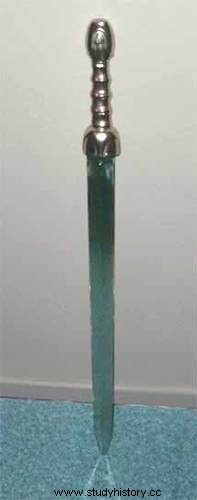Spatha is the Greek name ("spathê") for the longsword, used to refer to the late Roman longsword, the sword of the great invasions and the Merovingian sword. It is characterized by a wide blade as well as a narrow and flat guard.

The Spatha appeared earlier in the Roman army as a cavalry weapon .
Indeed the Glaive (gladius) was too short to strike a man on the ground from the high position of the rider. In addition, the Spatha has a much more effective cutting function than the Gladius. However, on horseback, in the middle of a melee, it is impossible to use a thrusting weapon since the neck and the head of the horse constitute an obstacle between the rider and his opponent. The longer spathe was used to cut, or at least to bruise in case of good protection, by lateral and vertical arm movements given on either side of the horse's flanks and not forwards.
The thrusting weapon of the Cavalry seems to be the contus, used by the Roman heavy cavalry in their charges (often of Sarmatian or Aline origin).
